
Posted on 01/05/2013 6:40:06 AM PST by Homer_J_Simpson

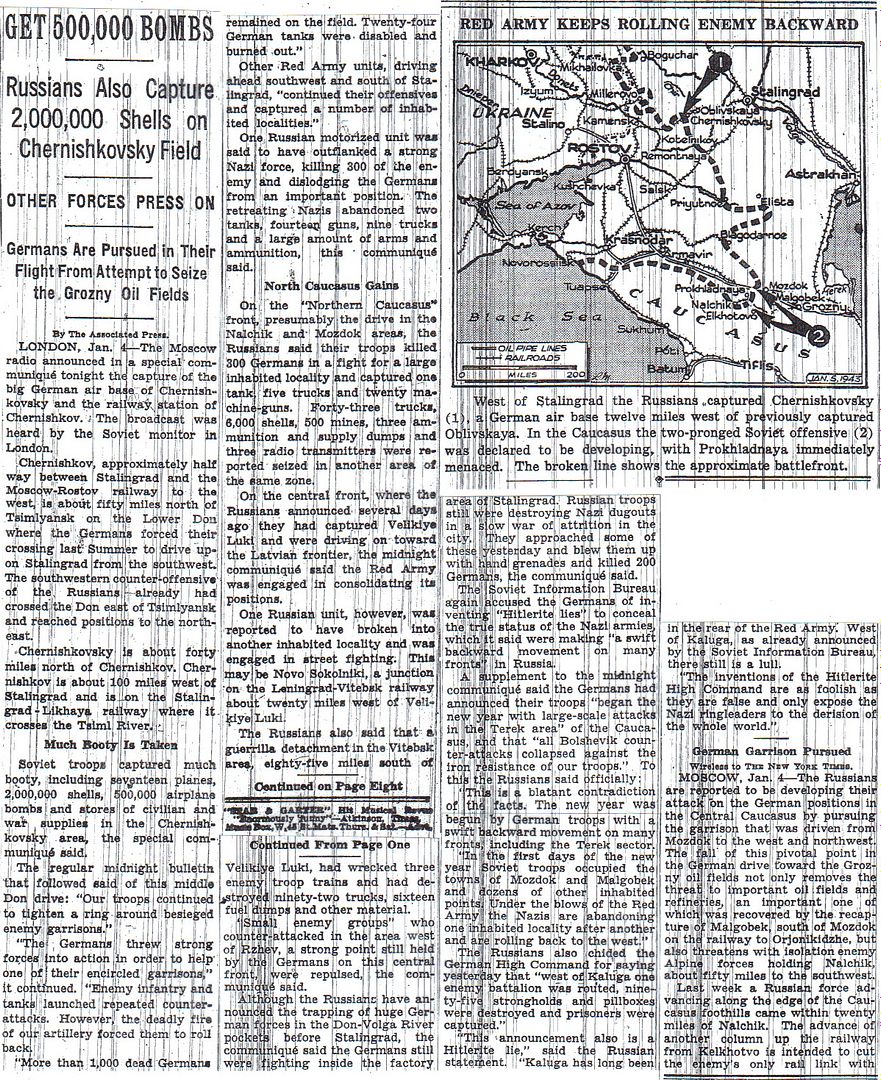
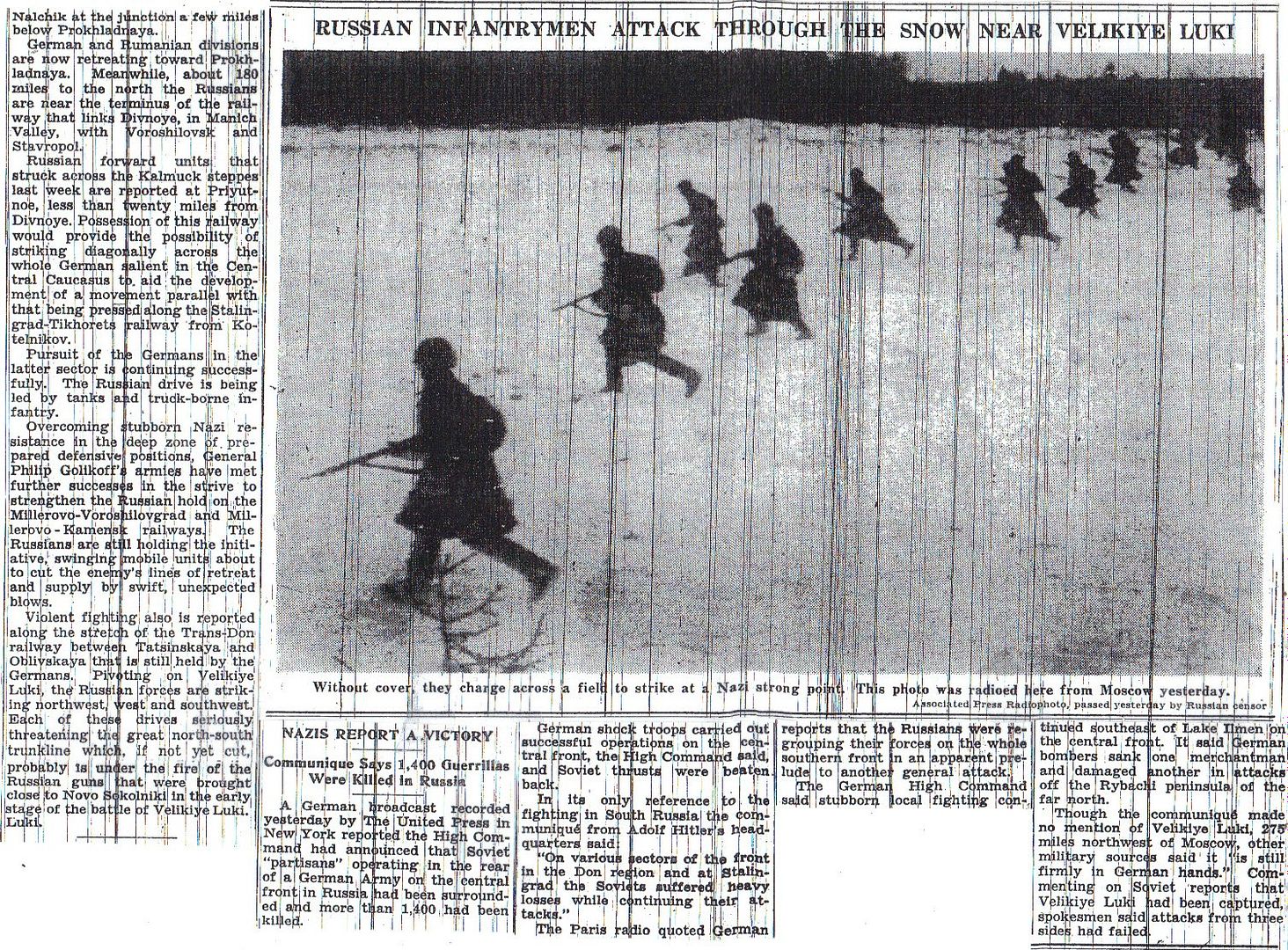

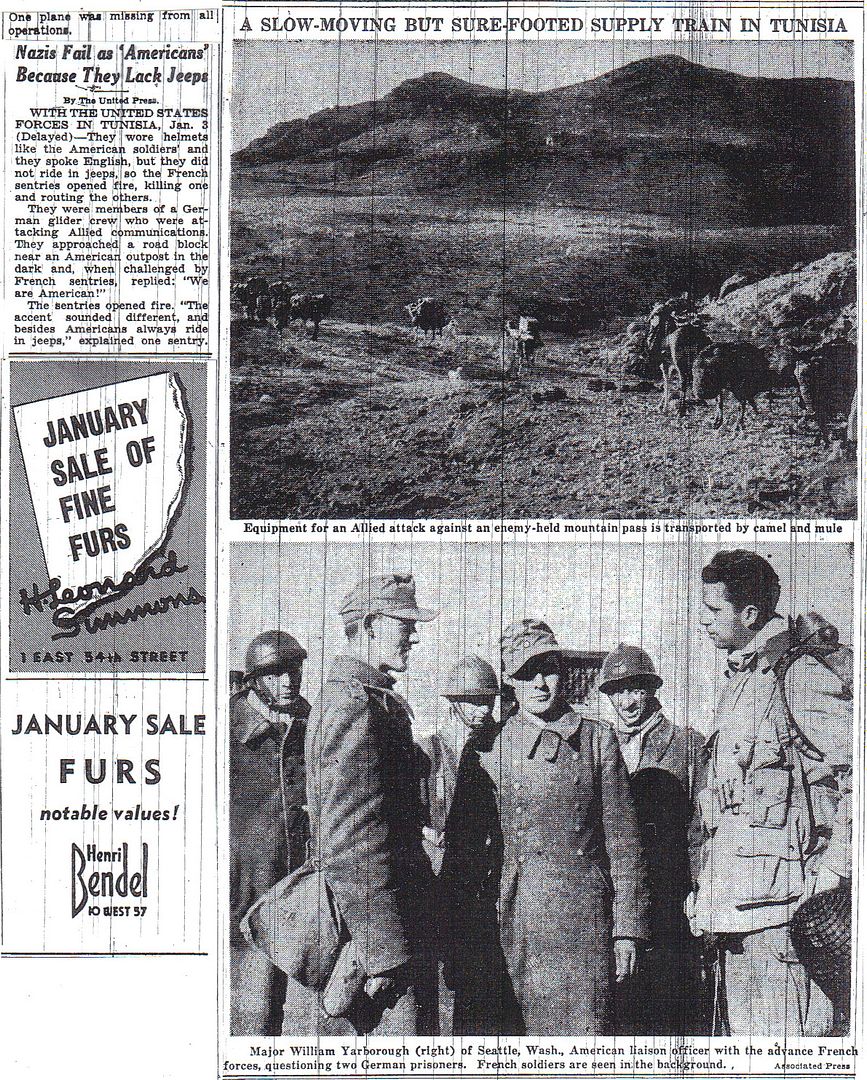

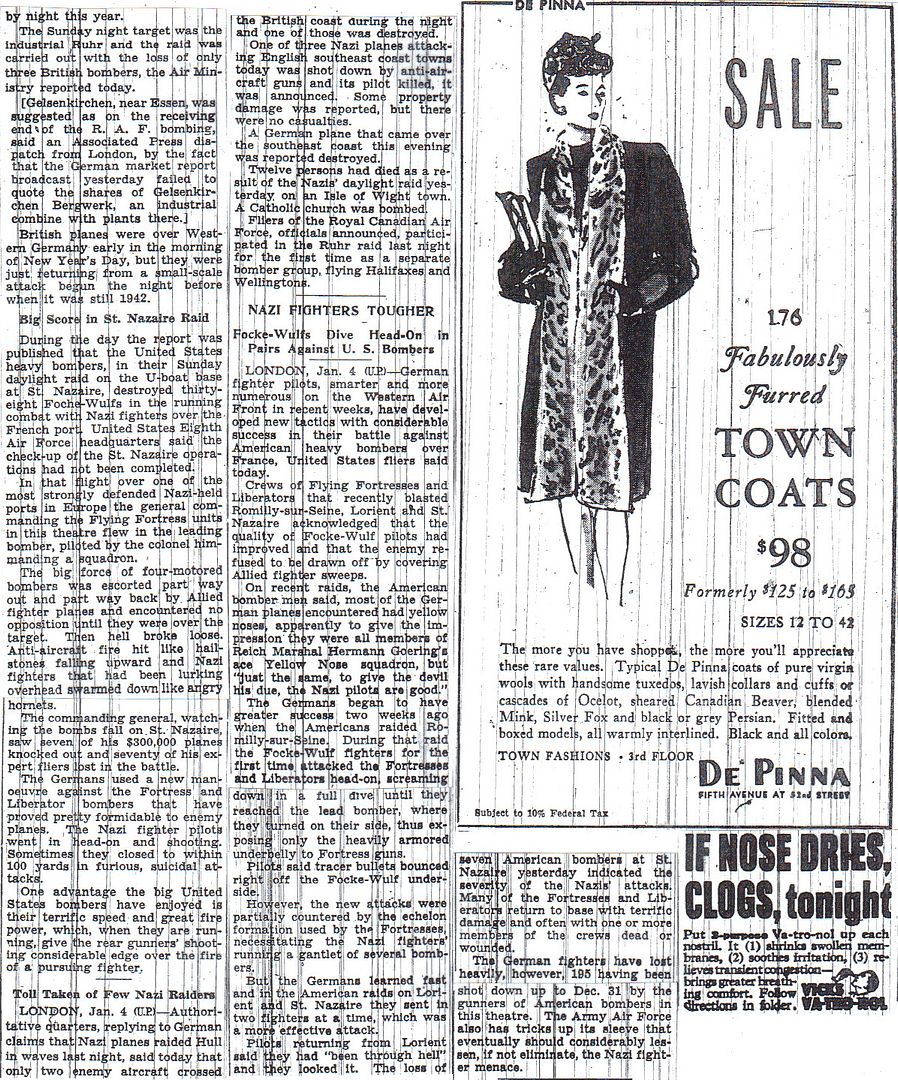
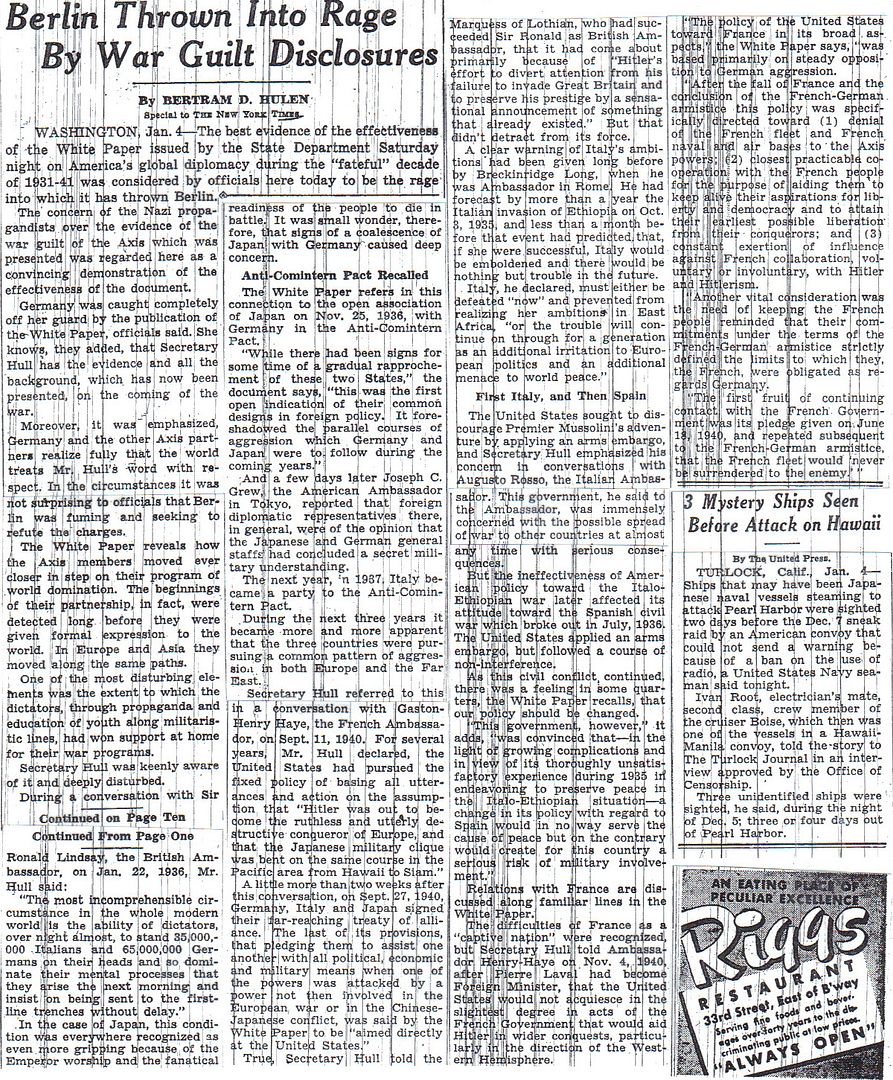

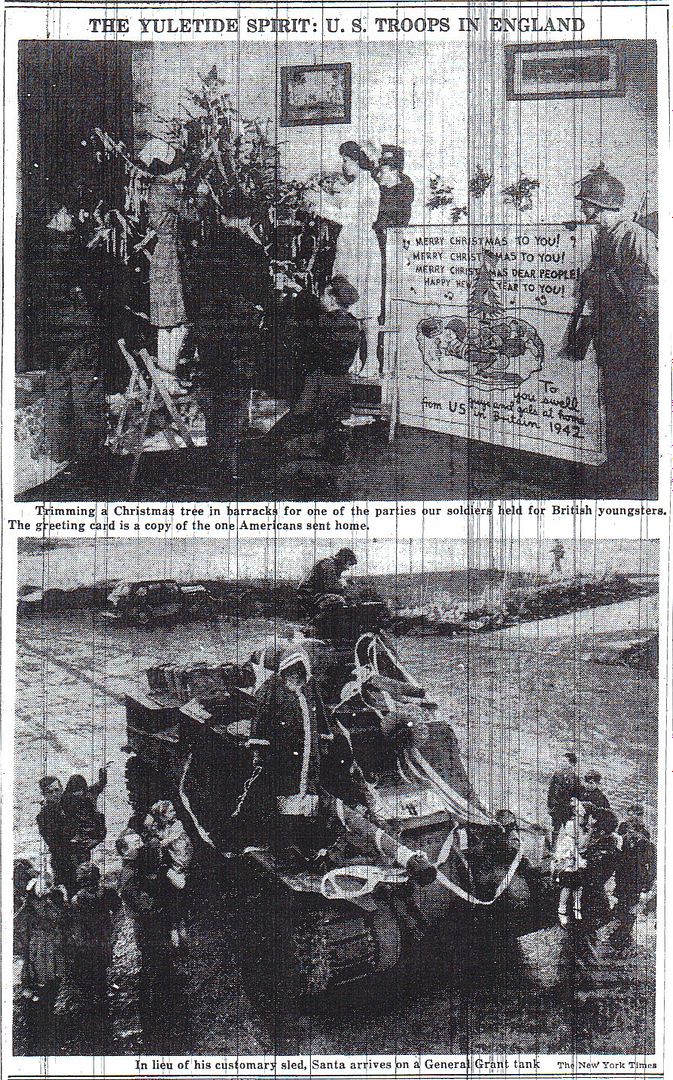
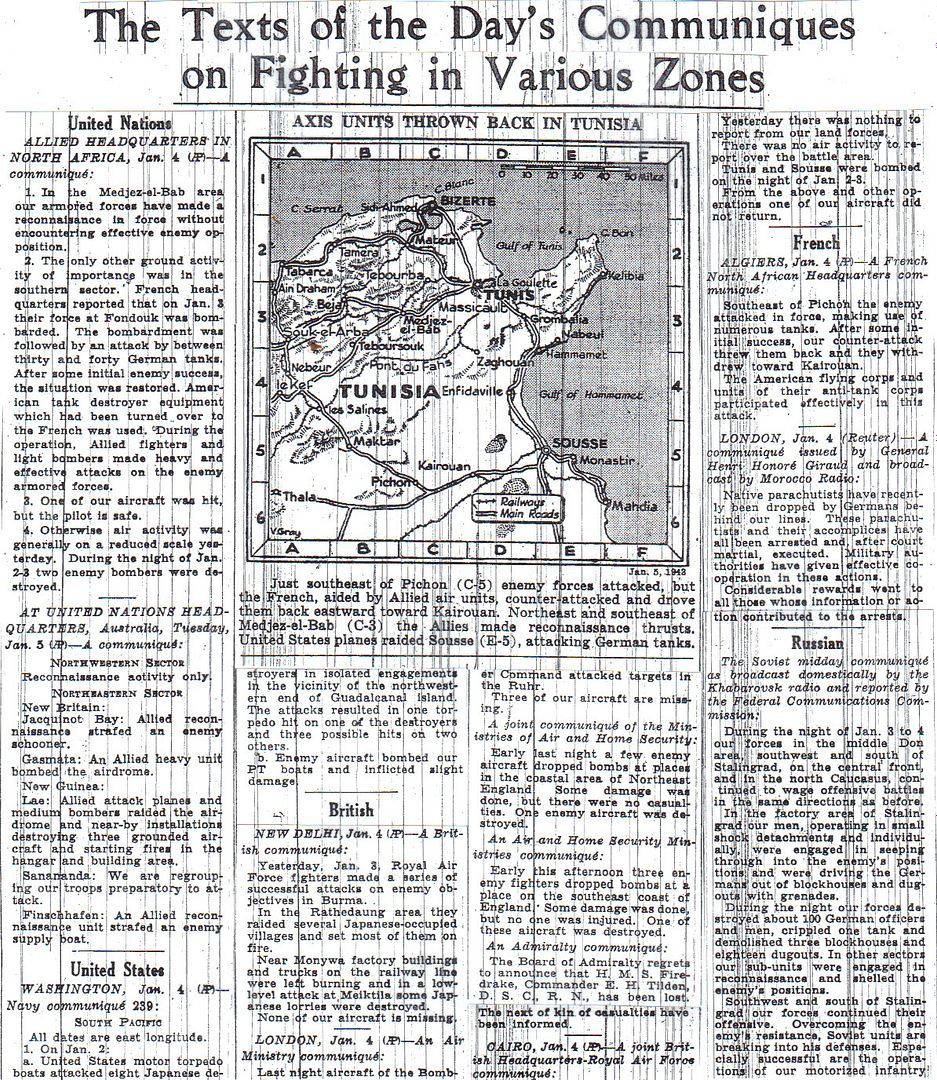
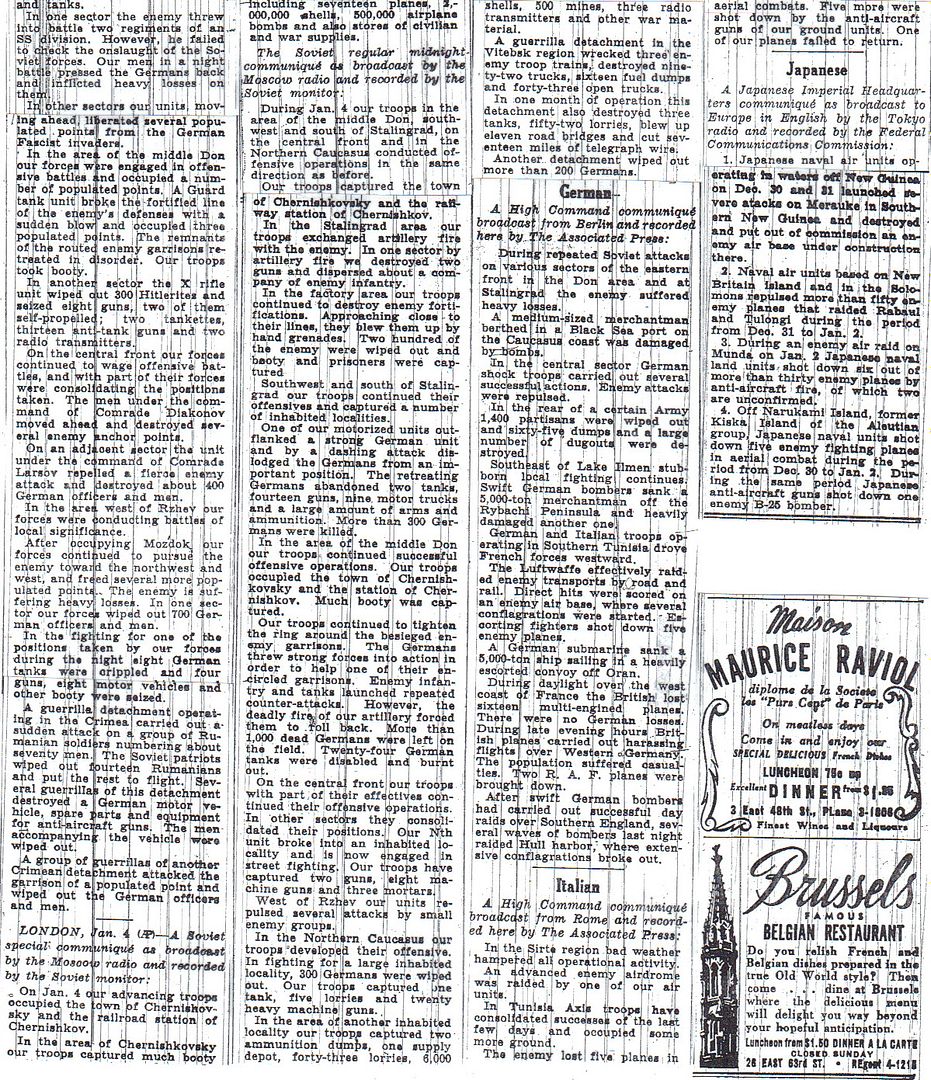
http://www.onwar.com/chrono/1943/jan1943/f05jan43.htm
Japanese Withdrawing from Guadalcanal
Tuesday, January 5, 1943 www.onwar.com
In the Solomon Islands... On Guadalcanal the Japanese begin their planned withdrawal. US forces fail to take note of the evacuation. Japanese resistance on Mount Austen is maintained despite growing American pressure.
In Tunisia... British forces make small gains near Djebel Azzag, west of Mateur. The US 5th Army, under the command of General Clark, becomes operational.
On the Eastern Front... In the Caucasus the Soviets take Prokhladny. Red Army forces consolidate their gains farther north by taking Morozovsk and Tsimlyansk.
http://homepage.ntlworld.com/andrew.etherington/frame.htm
January 5th, 1943 (TUESDAY)
UNITED KINGDOM: London: The Axis powers were given warning today that they will be forced to hand back the vast quantities of loot they have carried off from occupied countries. A foreign office statement claimed that the robberies have “taken every form from open looting to the most cunningly camouflaged financial penetration” and include works of art, bullion, banknotes, shares and commodities. Neutral countries used as hideaways by Axis agents will have to surrender all stolen property. The warning is issued jointly by Britain and 16 allies.
Escort carrier HMS Ranee laid down. (Dave Shirlaw)
GERMANY:
U-865, U-928 laid down.
U-541 launched. (Dave Shirlaw)
ITALY: The US 5th Army under General Mark Clark becomes operational.
U.S.S.R.: Soviet forces take Tsimlyansk and Morozovsk, the main airfield used by the Luftwaffe to supply Stalingrad.
Caucasus: The Red Army is pushing down from Stalingrad towards Rostov-on-Don with the intention of trapping General von Kleist’s Army Group A in the Caucasus. They have only 60 miles to go, while von Kleist’s nose is stuck into the Caucasus mountains some 400 miles away. That nose has been bloodied in the past few days with the Russians recapturing the important towns of Mozdok and Nalchik. Another Soviet drive is developing towards Elista, on the Kalmyk steppe, threatening Armavir, a key link in von Kleist’s communications with Rostov. If the Soviets cut him off they will win a great victory, and Hitler at first seemed to make that possible by refusing to allow von Kleist to withdraw.
He has now changed his mind and von Kleist is conducting a fighting retreat while von Manstein struggles to hold Rostov open for him to escape. It will not be easy. Der Montag reports: “Russian tanks come on in solid masses. Between them go units of long-distance ski and snowshoe runners. They carry with them even in the deepest snow, mortar batteries and anti-tank rifles.
TUNISIA: The Allies make a small advance near Mateur.
The V Corps, British First Army, breaks off action on Djebel Azag and Djebel Ajred after hard fighting in heavy rain, withdrawing the assault force (36th Brigade, 78th Division) to their original positions. (Jack McKillop)
Ten USAAF Ninth Air Force B-24 Liberators bomb Sousse harbour (clouds obscure the primary target at Tunis). (Jack McKillop)
Eighteen USAAF Twelfth Air Force B-17 Flying Fortresses, with a large P-38 Lightning escort, attack the Sfax power station while fighter-escorted B-26 Marauders hit the Kairouan Airfield. One B-17 is lost. Other fighters fly patrols, reconnaissance and C-47 Skytrain escort. (Jack McKillop)
During the night of 5/6 January, RAF Liberators of No. 160 Squadron hit the harbours at Tunis and Sousse. (Jack McKillop)
ALGERIA: In an organizational change, the Allied Air Force is activated to have operational control of Allied air units in Northwest Africa under the command of USAAF Major General Carl Spaatz. The new unit includes the USAAF Twelfth Air Force, the RAF Eastern Air Command and such French air units as might be assigned or attached to it. The command serves under the direction of Lieutenant General Dwight Eisenhower, Commander-in-Chief, Allied Forces. (Jack McKillop)
FRENCH MOROCCO: The US Fifth Army is activated under Lieutenant General Mark W. Clark, with headquarters at Oujda. (Jack McKillop)
NEW GUINEA: In Papua New Guinea, advance elements of the Australian 9th Division’s 18th Brigade (2/9th Battalion and brigade headquarters) and four tanks of the 2/6th Armoured Regiment reach Soputa. Additional tanks and artillery are kept east of the river for some time because of poor road conditions. As a preliminary to all out offensive against Sanananda, the U.S. 127th Infantry Regiment, 32d Infantry Division, starts northwest along the coast toward Tarakena. (Jack McKillop)
In Papua New Guinea, USAAF Fifth Air Force B-26 Marauders again bomb the Sanananda Point area and A-20 Havocs and B-25 Mitchells hit the airfield at Lae. (Jack McKillop)
SOLOMON ISLANDS: The Japanese begin withdrawal of troops from Guadalcanal while the Gifu continues to hold out.
Major General Alexander Patch, Commanding General US XIV Corps on Guadalcanal issues his 1st phase orders for clearing Guadalcanal. He sets a line from the beach inland 3500 yards, which is 3000 yards west of the US lines as his first objective. This area contains the Gifu, the Seahorse and the Galloping Horse as the well known geographical features and/or Japanese defensive positions. The newly arrived 25th Division will lead this phase. In the movie The Thin Red Line, the Galloping Horse is known as the Dancing Elephant.
HMNZS Achilles joined a US Navy Task Force in the bombardment of Japanese positions on Munda and Kolombangara islands during the Guadalcanal operations, and suffered some damage during a Japanese air attack. (Dave Shirlaw)
On Bougainville, USAAF B-17 Flying Fortresses with P-38 Lightning escort attack a cruiser at Buin on the southern coast. They are met by 25 “Zeke” (Mitsubishi A6M, Navy Type 0 Carrier Fighters) and float biplanes; three Japanese aircraft are shot down for the loss of two P-38s. (Jack McKillop)
After bombarding airfield and installations at Munda, New Georgia, Solomon Islands, Task Group 67.2 heads south and joins the rest of Task Force 67. TG 67.2 is comprised of four light cruisers, HMNZS Achilles (70) and USS Helena (CL-50), Nashville (CL-43) and St. Louis (CL-49) and three USN destroyers. Japanese planes attack the force, near-missing USS Honolulu (CL 48) and damaging HMNZS Achilles (70), 18 nautical miles (33 kilometres) south of Cape Hunter, Guadalcanal. In the action, USS Helena (CL 50) becomes the first USN ship to use Mk. 32 proximity-fuzed projectiles in combat, downing a “Val” dive bomber (Aichi D3A, Navy Type 99 Carrier Bomber) with her second salvo. (Jack McKillop)
US Navy gunners in the Pacific today become the first to fire shells equipped with the revolutionary new VT or proximity fuse. This consists of a tiny transmitting and receiving radio set which automatically detonates a shell at a predetermined distance from its target. The fuze transmits a radio beam, which, when it strikes a solid object, is reflected by that object and picked up by the receiver of the fuze. The beam then trips a switch within the fuze which detonates the shell. (W.D O’Neil)(217 p.257)
On Bougainville, USAAF B-17 Flying Fortresses with P-38 Lightning escort attack a cruiser at Buin on the southern coast. They are met by 25 “Zeke” (Mitsubishi A6M, Navy Type 0 Carrier Fighters) and float biplanes; three Japanese aircraft are shot down for the loss of two P-38s. (Jack McKillop)
BISMARCK ARCHIPELAGO: Six USAAF Fifth Air Force B-17 Flying Fortresses and six B-24 Liberators bomb the harbour, shipping and the airfield at Rabaul, New Britain Island. Two B-17s are lost, one taking Brigadier General Kenneth Walker, Commanding General V Bomber Command, to his death. (Jack McKillop)
NEW BRITAIN: Rabaul: Brigadier General Kenneth N. Walker, U.S. Army Air Corps, Commander of V Bomber Command is awarded the MoH for his actions today.
For conspicuous leadership above and beyond the call of duty involving personal valour and intrepidity at an extreme hazard to life. As commander of the 5th Bomber Command during the period from 5 September 1942, to 5 January 1943, Brig. Gen. Walker repeatedly accompanied his units on bombing missions deep into enemy-held territory. From the lessons personally gained under combat conditions, he developed a highly efficient technique for bombing when opposed by enemy fighter airplanes and by antiaircraft fire. On 5 January 1943, in the face of extremely heavy antiaircraft fire and determined opposition by enemy fighters, he led an effective daylight bombing attack against shipping in the harbour at Rabaul, New Britain, which resulted in direct hits on 9 enemy vessels. During this action his airplane was disabled and forced down by the attack of an overwhelming number of enemy fighters. (Patrick Holscher)
TERRITORY OF ALASKA: ALEUTIAN ISLANDS: Three USAAF Eleventh Air Force B-25 Mitchells sink a 6,500-ton cargo vessel previously sighted by a USN PBY Catalina off Holtz Bay on the northeast side of Attu Island, where a weather and armed reconnaissance B-24 Liberator with a direct bomb hits and sinks another freighter shortly afterwards. A B-24 flies photographic reconnaissance over Amchitka Island, concentrating on Constantine Harbour. A Kiska Island attack mission of six heavy bombers, six medium bombers and 12 fighters is cancelled due to weather. (Jack McKillop)
CANADA: : The Supreme Court of Canada upholds the War Measures Act, passed in 1914, which gives the federal Cabinet emergency powers to govern by decree when it perceives the existence of “war, invasion or insurrection, real or apprehended.” (Jack McKillop)
Corvette HMCS Agassiz commenced refit Liverpool, Nova Scotia.
Corvette HMCS Riviere du Loup laid down. (Dave Shirlaw)
U.S.A.: William Jay Stone commences basic training, AARTC at Fort Eustis, Virginia. (William Jay Stone)
The conviction of Gordon K. Hirabayashi, who violated Seattle, Washington’s curfew and exclusion restrictions on 16 May 1942, is reaffirmed by the Ninth U.S. Circuit Court of Appeals in San Francisco, California. (Jack McKillop)
The US Army forms the 122nd Infantry Battalion (Separate). It is formed with personnel of Greek ancestry, at Camp Carson, Colorado. (Nick Minecci)
Educator and scientist George Washington Carver died in Tuskegee, Ala., at age 81.
In baseball, the teams agree to start the season later than usual and prepare to train in northern areas because of the war. Resorts, armouries, and university facilities are chosen for training sites. The Brooklyn Dodgers will train at Bear Mountain, New York; the St. Louis Cardinals in Cape Girardeau, Missouri; and the New York Yankees at Atlantic City, New Jersey. (Jack McKillop) r and scientist George Washington Carver dies in Tuskegee, Ala., at age 81. On July 14, President Roosevelt will dedicate $30,000 for the George Washington Carver National Monument west-southwest of Diamond, Missouri - an area where Carver had spent time in his childhood. This was the first national monument dedicated to an African-American and first to a non-President. At this 210-acre national monument, there is a bust of Carver, a nature trail, a museum, the 1881 Moses Carver house, and the Carver cemetery. The National Monument will open in July, 1953. (Tony Morano)
Escort carrier USS Guadalcanal laid down.
Minesweeper USS Penetrate laid down.
Submarines USS Perch and Gabilan laid down.
Minesweeper USS Chief launched. (Dave Shirlaw)
Educator and scientist George Washington Carver died in Tuskegee, Ala., at age 81. Before and after his death, there was a movement to establish a U.S. national monument to Carver. However, because of World War II such non-war expenditures were banned by presidential order. Missouri Senator Harry S Truman sponsored a bill anyway. In a committee hearing on the bill, one supporter argued that “The bill is not simply a momentary pause on the part of busy men engaged in the conduct of the war, to do honour to one of the truly great Americans of this country, but it is in essence a blow against the Axis, it is in essence a war measure in the sense that it will further unleash and release the energies of roughly 15,000,000 Negro people in this country for full support of our war effort. The bill passed in both houses without a single vote against.
I see Lehman Brothers was stealing then too
Gee...there was a time when the NEW YORK TIMES was on our side!
Before I was born.
They were probably on the Soviet’s side. It was just lucky we were their allies.
" 'One wants to live,' wrote Salmen Lewental.
Those words are part of a notebook buried and found near the ruins of Birkenau's crematorium III.
Selected for labor when he entered Auschwitz on December 10, 1942, Lewental was put in the Sonderkommando a month later and condemned to work in the gas chambers and crematoria.
He lasted long enough to join the Sonderkommando uprising on October 7, 1944.
The date of his death is unknown.
"At one point in Lewental's notebook, he imagines someone asking him, 'Why do you do such ignoble work?'
Beyond answering that 'one wants to live,' there is no good reply, for what good choices did Lewental have?
"Nazi power repeatedly forced defenseless people to make what Holocaust scholar Lawrence L. Langer calls 'choiceless choices.'
Such choices, he says, do not 'reflect options between life and death, but between one form of 'abnormal' response and another, both imposed by a situation that was in no way of the victim's own choosing.'
"Such was Lewental's miserable situation.
He did not volunteer for the Sonderkommando any more than he chose deportation.
Lewental was like millions of Holocaust victims.
In Auschwitz his 'choices' --dying by suicide, dying by resisting, or dying as a Sonderkommando--were essentially 'choiceless.' "
""People lived and vanished overnight in this place," wrote Holocaust survivor Elie Wiesel.
Polish people call that place Oswiecim, but it is better known as Auschwitz, its German name.
That place is synonymous with the Holocaust itself.
"The town of Oswiecim, whose prewar population of 12,000 included 5,000 Jews, stands 40 miles west of Kraków in Upper Silesia, a southwestern Polish province that the Nazis annexed to the Third Reich.
Situated on major railroad lines and near the confluence of the Sola and Vistula rivers, Oswiecim was also the site of former Polish military barracks.
They became the nucleus of Auschwitz, the Nazis' most notorious network of concentration, forced-labor, and death camps.
"On April 27, 1940, Heinrich Himmler, head of the Nazi SS, ordered the establishment of a concentration camp at Oswiecim.
Under the command of Rudolf Höss, the early Auschwitz inmates were mostly Polish political prisoners.
Soon, as its territory and population expanded, Auschwitz became several camps in one.
On March 1, 1941, Himmler called for a second section--Auschwitz II--and constructon began in October.
By the end of 1941, a third expansion was under way.
Auschwitz III was known as Buna-Monowitz, taking its name from the Buna synthetic-rubber factory at Monowice, which slave laborers built for I.Gi. Farben, the German industrial firm.
"When it came to the destruction of human life, no part of Auschwitz could compare to Auschwitz II, also known as Birkenau, the German name for Brzezinka, the Polish village near the site.
Located 1.5 miles from the Stammlager (Auschwitz I, the "main camp"), Auschwitz-Birkenau became the Third Reich's top killing center.
By early summer 1943, it had one small gas chamber built two years earlier, plus four state-of-the-art gas chamber-crematoria installations, whose chief purpose was to murder Jews and others on an assembly-line basis.
"German engineers estimated that these four crematoria could incinerate 4,415 bodies a day.
That number, though, was less than the gas chambers' daily capacity.
Thus, efforts were made to double the rate of corpse disposal by reducing the incineration time and increasing the number of bodies that could be burned at once.
Pushed beyond capacity, Birkenau's killing machinery periodically malfunctioned.
Nevertheless, it destroyed hundreds of thousands of Jews in 1943 and especially in 1944. "In all of its dimensions, Auschwitz spelled suffering and death.
If not murdered in the gas chambers, prisoners died of starvation and disease.
Slave laborers worked in hideous conditions until they perished.
Deportees came from every European region and included German 'undesirables,' Soviet prisoners of war, Gypsies, Polish priests and nuns, French Resistance members, and--most of all--Jews.
Between 1.1 and 1.5 million men, women, and children--90 percent of them Jewish--perished in that place."
"Sister Marejanna Reszko was the head of the convent of St. Anthony in Ignacow, Poland. **
She rescued numerous Jewish girls by hiding them in her orphanage.
When asked if one of her charges, Frida Aronson, was Jewish, her reply was that she did not care--she assisted all those who needed it."
From the article: "The adventures of three members of a United States Navy photographic unit, who spent about three weeks 'cruising' among forward units of the British First Army in the Tunisian campaign, taking pictures, being cut off by the Germans and helping to destroy German tanks, were described today by two officers of the unit, Lieutenants John McClain and Kenneth M. Pier, both of Hollywood."
This experience would be valuable preparation for McClain when he was involved in a siege of the Nakatomi Plaza building in Los Angeles at Christmas 1988.

Yippee-Ki-Yay!
I don’t consider these Chronicles anti-Christian at all. Regardless of what the Nazis thought about themselves, I have never considered them Christian; on the contrary, they were the very embodiment of doing the Devil’s work.
Disclaimer: Opinions posted on Free Republic are those of the individual posters and do not necessarily represent the opinion of Free Republic or its management. All materials posted herein are protected by copyright law and the exemption for fair use of copyrighted works.